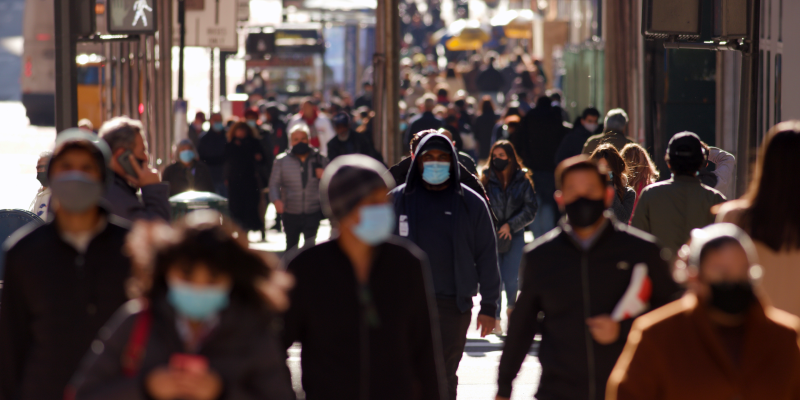“I probably shouldn’t make any predictions because you’re invariably wrong with this virus when you make predictions. But I really do think that by next fall we could have life back to normal…”
– Dr. Paul Offit, Director of the Vaccine Education Center at Children’s Hospital of Philadelphia, December 2020.
In early 2021, experts predicted that when enough people were either vaccinated or infected, the virus would evolve from a serious economic-crippling global pandemic to an illness that mostly affected children with something that resembled a common cold. Unfortunately, that’s not yet the case.
Today, the virus is surging as a result of the Omicron variant. And Dr. Offit’s prediction that “we could have life back to normal…” is unlikely to happen for a while.
It’s difficult to predict how the virus will evolve due to the varying levels of vaccinations globally. However, the Job to Be Done theory provides a framework that can help us combat the spread of the virus in 2022.
Developed by the late Professor Clayton Christensen and his longtime collaborator Bob Moesta, the Theory of Jobs to Be Done (or Jobs Theory) is an incredibly useful framework that helps innovators better understand consumer behavior. It highlights the fact that people don’t simply buy products or services; they hire them to make progress in specific circumstances (what we call their Job to Be Done, or for short “job”).
Jobs Theory goes beyond superficial categories to expose the functional, social, and emotional dimensions that explain why people make the choices they do.
The functional dimension is simple: the product or service must function in a way that helps the consumer overcome a struggle. In the case of the COVID-19 vaccines, they must inoculate people against the virus.
The social dimension of the job is about the way others view the consumer using the product or service. Regarding the COVID-19 vaccines, if I experience life with a community of people who will reward or respect me for taking the vaccine, I’m more likely to take it. The converse is also true. No matter the efficacy of a vaccine, it will be difficult to consume if people will be looked down upon by those with whom they experience life.
And finally, the emotional dimension of the job is about how the product or service makes the consumer feel. Once again, in the case of the vaccines, they must make people feel good about themselves. The health benefit isn’t simply enough.
Simply put, to perfectly nail the job, innovators must focus on understanding the functional, social, and emotional dimensions.
Using Jobs Theory to assess vaccination rates and how seriously people take the pandemic can shed some light on how we can make progress against the virus in 2022.
For example, in some parts of the United States where there’s ample supply of vaccines, fewer than half the population have “consumed” the vaccine. For context, 85% of people in Cuba are fully vaccinated and approximately 70% of Mongolians have received at least one dose.
The issue isn’t the functional component of the job. The vaccine, for the most part, works. Although we do not know if there’ll be long-term side effects of the vaccine–or of COVID–we have a good idea of the short-term effects of both.
Vaccinated people are five times less likely to contract COVID-19 and 13 times less likely to die from it. In addition, in terms of efficacy, the world has never experienced such a mass vaccination drive in such a short time. Close to nine billion doses of COVID-19 vaccines have been administered without reports of major side effects.
Yet hundreds of millions of people who can, still refuse to “consume” the vaccine.
In less wealthy countries, the situation is slightly different. People may believe in COVID-19, but when faced with the daily struggles of hunger, joblessness, and poverty, it is hard to take the pandemic seriously. In fact, more than half a billion people have been pushed into poverty since the pandemic began.
The Jobs Theory helps us understand that, in dealing with this pandemic, solving the functional component of the job has gotten us as far as it can. Now, leaders must solve for the social and emotional components of the job.
So, in addition to speaking out about the health benefits of the vaccines, they must work to understand the context of the hundreds of millions of people who can, yet still refuse to take the vaccine. Once they understand, they must then work to develop viable solutions that help nail the social and emotional dimensions.
In poor countries, leaders must understand that a majority of people don’t “struggle” directly with the pandemic. They struggle with poverty, employment, and a severe lack of basic needs like food, clothing, and shelter. By framing solutions to the pandemic in the context of what people struggle with, leaders in these countries will be more successful at combating this seemingly never ending pandemic.
As we begin 2022, it is clear that we need a different approach to combat the pandemic or new variants will continue to emerge. Jobs Theory provides a helpful framework for us to consider. Hopefully, by this Fall we might get closer to a level of normalcy for which we are all accustomed.


